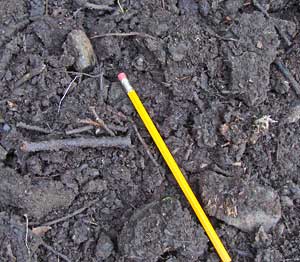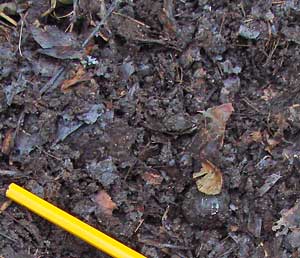Above, a volunteer digs soil up from an alley and puts it on the bed or underneath fall vegetables. If the compost is well broken down (as in the middle top photo), I put it in a storage bin; this is good material for seedbeds.

Chunky material forms in the narrower alleys where a lot of soil get's mixed in with the leaves, (When the alleys are dug out, soil that has slumped over the edges of the beds gets mixed in directly, also I think worms bring a lot in.)

In wider alleys where there is less soil mixed in, the compost goes through a flaky rather than chunky stage. |
Nutrients
As well as building up the beds physically, the compost adds nutrients. Most of the added nitrogen is in the form of humus which breaks down slowly. It takes a few years for the annual release of nitrogen from humus to be sufficient to satisfy most of the needs of nutrient demanding annuals such as lettuce and broccoli So I gave or give (in newer beds) those some nitrogen supplements, usually as feathermeal in the seedbed. I do so sparingly, and repeat applications if they are beginning to look like they need it. For the latter, I use a liquid fish fertilizer or a liquid emulsion made by putting some feathermeal in a container, adding water and letting it sit (I use about 1/5 th by volume feathermeal, 4/5 water.) Perennials generally do not need any nitrogen supplements.
I have measured the levels of nitrate in the trenches and in garden beds. Nitrate is produced only after compost has fully matured. There is no measurable nitrate within one year in the trenches, so the chunky material I put it on the surface of the beds in the fall is still immobilizing (tying up any free nitrogen); this is desirable as it helps to conserve nitrogen and other nutrients over the winter and spring. Nitrate is observed in compost after all traces of the original leafy materials have disappeared and the compost has a a good crumb structure (as in the top middle photo). i generally store this material in bins with a few holes in the sides to let it dry out which conserves the free nitrogen.
Compost is generally rich in phosphorous, which is also conserved in the soil as iut resides mostly in non-leachable forms. On the other hand, compost tends to be deficient in potassium, and potassium tends to leach quite readily from soils. So I occasionally sprinkle some potash or potassium sulfate on the garden beds. Compost has a liming effect, so I don't need to put lime into these beds.
|

